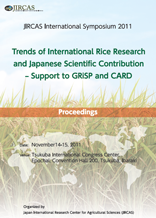Utilization of Abiotic Stress Tolerance Genes

Abiotic stresses such as drought, salinity, flooding or problem soils limit crop production worldwide.
Resource-poor farmers are disproportionally affected because they typically lack the resources to alleviated
effects of stress through improved water management or soil amendments. The development of cultivars with
enhanced tolerance to abiotic stresses has therefore been advocated as a low-cost means to improve
productivity in stressful environments (Ismail et al. 2007). In the past, efforts to develop such varieties have
typically relied entirely on phenotypic selection in target environments but the tremendous success of marker
assisted selection (MAS) for the Sub1 locus enhancing submergence tolerance (Septiningsih et al. 2009) has
clearly established MAS as the potential method of choice in breeding for abiotic stress tolerance.
Several other loci associated with tolerance of drought, P deficiency, salinity, or anaerobic germination
have entered breeding programs by now. Among these is the Pup1 locus enhancing tolerance to P deficiency,
which had originally been mapped in 1998 in the Nipponbare x Kasalath mapping population. That it took
more than a decade before Pup1 was finally cloned and suitable markers developed for use in MAS was in
large part due to the absence of Pup1 from the rice reference genome based on Nipponbare, which is sensitive
to P deficiency. The underlying gene was therefore only identified after sequencing the Pup1 region in tolerant
donor parent Kasalath (Chin et al. 2011). Similar difficulties were encountered for the Sub1 locus: tolerance is
conferred by a tolerance-specific allele, Sub1A-1, that is entirely absent from the reference genome. These
examples highlight the need to have access to more detailed genomic information from the more exotic donors
of key tolerance genes.
For MAS to fulfill its true potential it is crucial to shorten the period from QTL detection to gene
identification and breeding application and to widen the genetic based beyond what is typically explored in a
bi-parental cross. Genome wide association mapping (GWAM), based on representative sets of genebank
accession that capture a very large part of the variation present in the rice gene pool, promises to accomplish
this through the simultaneous identification of loci controlling key tolerance traits with an allele mining
component (Zhao et al. 2011). In combination with low-cost high-throughput genotyping many limitations
with respect to genotyping are presently being lifted. In the near future, the crucial task will be to design
screening protocols that are equally high-throughput, while being specific enough to detect novel tolerance
genes suitable for entering MAS breeding schemes. Currently such protocols are being developed and
employed jointly between JIRCAS and IRRI to tag loci controlling traits enhancing phosphorus use efficiency
and zinc uptake from zinc-fixing soils.
| Date of issued | |
|---|---|
| Creator | Matthias Wissuwa |
| Subject |
Problem soils phosphorus efficiency zinc deficiency marker assisted selection association mapping |
| Publisher | Japan International Research Center for Agricultural Sciences |
| Available Online | |
| Issue | 2011 |
| spage | 76 |
| epage | 80 |
| Rights | Japan International Research Center for Agricultural Sciences |
| Language | eng |
